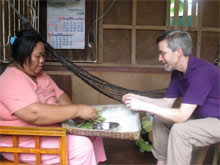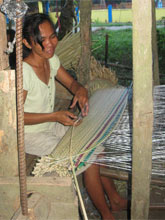
John preparing local string-beans with Delia. Photo by Robin Broad
Our search for rootedness has brought us back to the Philippines, back to communities in the south where Robin spent a year over three decades ago.
We spend time with the family of a rice farmer, Delia, on the southern Philippine island of Mindanao. Delia, her husband Romulo, two daughters, one son, and three grandchildren live in a simple but roomy house on the edge of their rice field. Behind the house is a tilapia-filled fish pond with papaya trees growing on one side. A few pigs are housed by the fish pond, and fifteen chickens have free range of the property. Vitamin-rich greens grow at the far edge of the pond, and two towering jackfruit trees provide shade as well as ingredients for delicious meals. Theirs is an example of what we call a “rooted” life; among other things, they eat mainly what they grow and raise.
So, too, is much of their other consumption locally-based—including our bedding. After dinner on the first night of our visit, surrounded by village kids, we walk five minutes up the road to the house of neighbor Ging-Ging. She is just finishing weaving two rattan mats for us on a wooden loom in her back yard. We chat as she weaves, and she explains the economics of her inputs and her time, convincing us that she still makes money on the one dollar that we pay for each.

Ging-Ging weaving our
bedding. Photo by John Cavanagh
Rice is central to Philippine culture, politics, the economy, and to most rural communities. It is also the biggest employer in the Philippines; over a third of the population still works in agriculture, and rice is still the largest crop. And, as we discover in several rice communities like Delia’s across the country, there are exciting shifts in the orthodoxy over what rice is planted and how it is grown.
After sleeping well on our new mats, we rise early with Delia’s family. It is the 15th of the month, which means that each family in the community must send one member to help cut weeds along the irrigation canal; those who fail to show are fined two dollars. This is one of several community tasks where all families here participate for the greater good, in this case keeping the canals free of weeds that would slow the water flow. The farmers move quickly, offering us their bolo knives so that we can join in.
At the edge of the irrigation canal, Delia proudly shows us her hectare of “zero-chem” rice and we discuss the traditional seeds she has planted. Part of the high expenses of chemical agriculture is that farmers must buy new hybrid seeds each planting season, a costly proposition. The traditional seeds that Delia and other organic farmers here are using are saved from the previous harvest or “in-bred” locally to work best in this particular area. Delia complains that the government’s agricultural extension agents sometimes give out free hybrid seeds, and that they mainly give seminars on chemical agriculture rather than providing support for “zero-chem” farming.
Delia and other organic farmers we meet are aware of the larger argument against traditional and inbred seeds and against organic agriculture overall: that it is “backward,” unscientific and can never compete with the high yielding seeds of chemical agriculture. Thus, it is often argued by proponents of chemical agriculture, it cannot feed the world. Africa is starving, the supporters of chemical farming say, and China is buying up farm land in other countries to feed its own people. Hence, higher yields are essential to feed a hungry world—or so goes the argument.
The older farmers we meet say that yes, when the new rice varieties were first introduced in the 1960s and 1970s “green revolution,” the expensive seeds and chemical fertilizers and pesticides often produced increases in yields. But they also tell us of falling productivity over the years as soils became compacted and depleted of the nutrients that get replenished with organic farming. And, farmers were often forced to take on more debts to pay for the inputs or else, though economic desperation, to cut back on the pesticides and fertilizers, cutting yields further. Some even had to sell their cherished land.
As we see for ourselves, Delia and her zero-chem neighbors are anything but backward; they are impressive scientists in their own right, constantly experimenting with different seeds and different amounts of water. Instead of chemical fertilizers and pesticides, they cook their own non-chemical “concoctions” to handle everything from rats to stem-boring insects to plant viruses (more on this in a later blog).
After using the zero-chem techniques for a couple of seasons, several tell us their yields are just below what they were with chemical farming. Others say their yields have stayed the same or actually gone up.
The successful initiatives of farmers like Delia to take back control of their lives and gain food security are significant for this community and for the Philippines. But they are more than that. What we find here—people rejecting a half-century of conventional “wisdom” in favor of more rooted alternatives—is happening in many parts of the United States and other countries as well.
John Cavanagh and Robin Broad wrote this article for YES! Magazine, a national, nonprofit media organization that fuses powerful ideas with practical actions. Robin is a Professor of International Development atAmerican University in Washington, D.C. and has worked as an international economist in the U.S. Treasury Department and the U.S. Congress. John is on leave from directing the Institute for Policy Studies, and is co-chair (with David Korten) of the New Economy Working Group. They are co-authors of three books on the global economy, and are currently traveling the country and the world to write a book entitled Local Dreams: Finding Rootedness in the Age of Vulnerability.